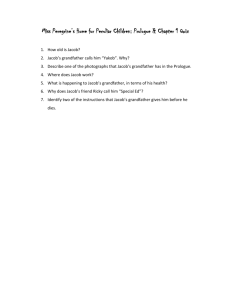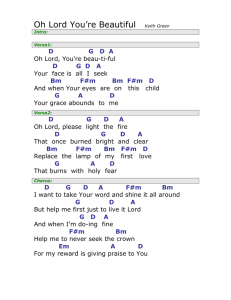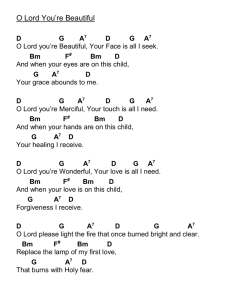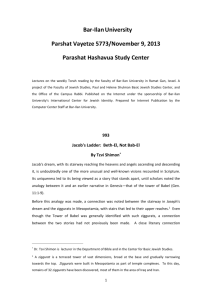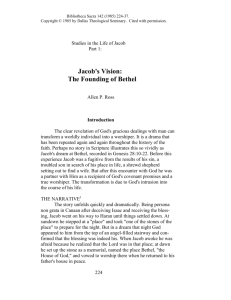Jacob`s Dream
advertisement
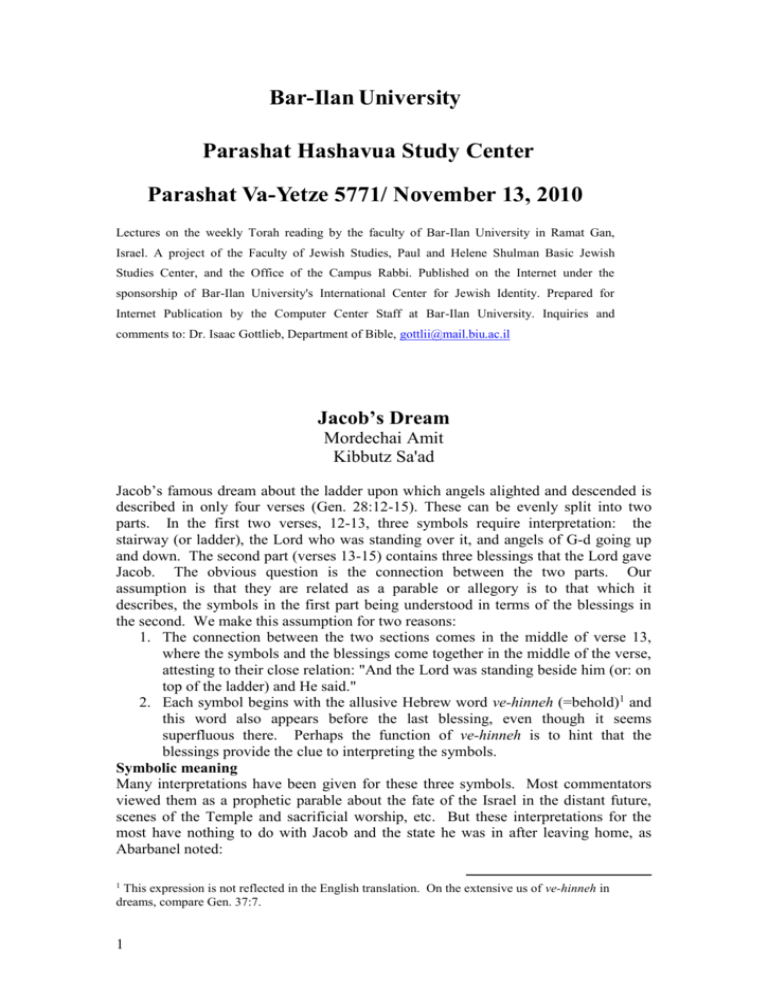
Bar-Ilan University Parashat Hashavua Study Center Parashat Va-Yetze 5771/ November 13, 2010 Lectures on the weekly Torah reading by the faculty of Bar-Ilan University in Ramat Gan, Israel. A project of the Faculty of Jewish Studies, Paul and Helene Shulman Basic Jewish Studies Center, and the Office of the Campus Rabbi. Published on the Internet under the sponsorship of Bar-Ilan University's International Center for Jewish Identity. Prepared for Internet Publication by the Computer Center Staff at Bar-Ilan University. Inquiries and comments to: Dr. Isaac Gottlieb, Department of Bible, gottlii@mail.biu.ac.il Jacob’s Dream Mordechai Amit Kibbutz Sa'ad Jacob’s famous dream about the ladder upon which angels alighted and descended is described in only four verses (Gen. 28:12-15). These can be evenly split into two parts. In the first two verses, 12-13, three symbols require interpretation: the stairway (or ladder), the Lord who was standing over it, and angels of G-d going up and down. The second part (verses 13-15) contains three blessings that the Lord gave Jacob. The obvious question is the connection between the two parts. Our assumption is that they are related as a parable or allegory is to that which it describes, the symbols in the first part being understood in terms of the blessings in the second. We make this assumption for two reasons: 1. The connection between the two sections comes in the middle of verse 13, where the symbols and the blessings come together in the middle of the verse, attesting to their close relation: "And the Lord was standing beside him (or: on top of the ladder) and He said." 2. Each symbol begins with the allusive Hebrew word ve-hinneh (=behold)1 and this word also appears before the last blessing, even though it seems superfluous there. Perhaps the function of ve-hinneh is to hint that the blessings provide the clue to interpreting the symbols. Symbolic meaning Many interpretations have been given for these three symbols. Most commentators viewed them as a prophetic parable about the fate of the Israel in the distant future, scenes of the Temple and sacrificial worship, etc. But these interpretations for the most have nothing to do with Jacob and the state he was in after leaving home, as Abarbanel noted: 1 This expression is not reflected in the English translation. On the extensive us of ve-hinneh in dreams, compare Gen. 37:7. 1 There is another reservation applying to them that can hardly be overlooked, namely that such a vision does not relate to Jacob, who was fleeing from his brother Esau for fear that he would kill him on account of the blessing his father had given him; and the vision which he saw had nothing to do with this.2 Abarbanel’s criticism is well taken. This is neither the time nor place to tell Jacob about what will happen to the people of Israel in the distant future, or to reveal divine secrets to him. Therefore let us try to interpret the symbols in the light of the blessings that come after them, with the relationship of a parable to that to which it applies. 1. The stairway stands on the ground and its top reaches the sky. The word sullam (=stairway) occurs nowhere else in the Bible. The dagesh in the letter lamed indicates that the root of this word is apparently s-l-l (= to pave, lay with stone). So it seems we should interpret this word as an extremely high ascent built of rocks. The first object of the parable speaks of the land that will be given Jacob and his offspring. If so, the stairway must symbolize it. Also consider its being linked to the ground (eretz, also = land), a word which appears in both parts. The stairway reaches heavenward, perhaps reminding us thematically of the verse, “It is a land which the Lord your G-d looks after, on which the Lord your G-d always keeps His eye, from year’s beginning to year’s end” (Deut. 11:12). In other words, Jacob is promised a land capable of maintaining agriculture and earthly existence, but his sons will be able to reach spiritual heights only if they satisfy the conditions that the Lord stipulates for them. 2. Angels of G-d going up and down. Since the blessing speaks of Jacob’s progeny, we suggest that “angels of G-d” symbolize the people of Israel. This might seem a far-fetched and strange interpretation, but only if one considers the Hebrew mal’achim as angels. If we consider the original meaning of this word, namely messengers, as in the verse, “Jacob sent messengers ahead” (Gen. 32:4), then this presents no difficulty: human beings can be messengers. Regarding the mission of the people of Israel, the Lord says (Gen. 18:18-19): “Abraham is to become a great and populous nation and all the nations of the earth are to bless themselves by him. For I have singled him out, that he may instruct his children and his posterity to keep the way of the Lord by doing what is just and right.” Jewish sources can help us, if only slightly, in identifying the messengers with the children of Israel. Exodus Rabbah 42, 3 reads: I told their elder (Father Jacob): “and angels of G-d were going up and down on it (Gen.28:12, Heb. bo).” What is meant by "on it" ( bo)? Thus I told him: when in the future your children shall be righteous, they shall go up in the world and rise, and their emissaries shall rise with them; but when they sin, they and their emissaries go down, as it says, "Get thee down" (Ex.32:7).3 This homily is not identical to our interpretation, but it identifies the messengers in Jacob’s dream, called angels, with the children of Israel [ed. 2 Abarbanel's comment on Gen. 28:12, the first after his summary of interpretations of the dream. Perhaps the word bo was thought to be superfluous and therefore explained as "by means of:" the leaders of Israel rise up and fall in this world dependent on the fortunes of the people of Israel. 3 2 note: perhaps the angels represent the leaders of Israel]. Our interpretation diverges somewhat from the homily. We associate the word bo “on it” with the stairway, but one could take the homily to be indicating Moses. 3. And behold, the Lord was standing alav (= on it or over him). On what or by whom? According to the blessing to which we apply this, clearly the reference is to the lord standing over Jacob, whom the Lord promises to protect along his way to Haran and to bring him back to the land, as Rashi comments (loc. sit.): “Stood over him to protect him.” Does this dream, as we have interpreted it, suit Jacob’s emotional state? Jacob, fearing Esau’s revenge, was fleeing from him to a foreign land. Even in Haran no great things awaited him. He was alone, destitute, in a condition that could lead one to despair, and the Lord came to him with the consoling words: the land that you are lying on as a refugee will one day be yours. It will be a land of special qualities. You are alone? Behold, the Lord is showing you your offspring, represented in the dream by the angles, who will be capable of reaching great heights if they adhere to what is required of them. And see how numerous you offspring shall be: like the dust of the earth. You are afraid of Esau, or perhaps of the future? The Lord will watch over you wherever you are. We think this message matches Jacob’s emotional state, and the two parts of the dream impart to each other depth of ideas and emotion. 3



